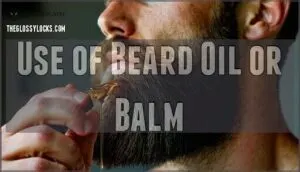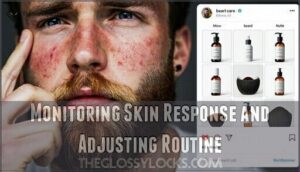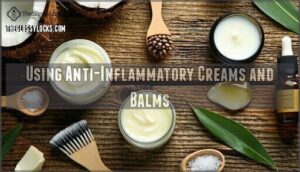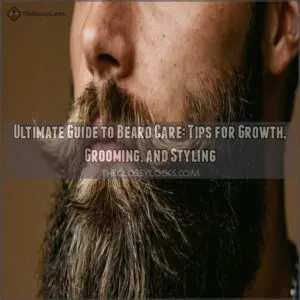This site is supported by our readers. We may earn a commission, at no cost to you, if you purchase through links.

This non itchy beard care guide starts with washing your facial hair daily using lukewarm water and a gentle cleanser—hot water strips away natural oils that keep your skin happy.
Apply beard oil while your hair’s still damp to lock in moisture and prevent that scratchy feeling.
Brush regularly with a boar bristle brush to distribute oils evenly and remove dead skin cells.
Trim split ends every few weeks to maintain healthy growth.
The secret lies in treating your beard like the crown it is—with consistent, gentle care that addresses both your hair and the skin underneath.
Table Of Contents
Key Takeaways
- Wash daily with lukewarm water and a gentle cleanser – Hot water strips natural oils that keep your skin comfortable, so stick to lukewarm temperatures and avoid harsh shampoos that’ll dry out your beard.
- Apply beard oil to damp hair after washing – This locks in moisture and prevents that scratchy sandpaper feeling by hydrating both your facial hair and the skin underneath.
- Brush regularly with a boar bristle brush – Daily brushing distributes natural oils evenly, removes dead skin cells, and prevents the buildup that causes irritation and itching.
- Trim split ends every few weeks – Regular trimming prevents sharp, damaged hair ends from poking and irritating your skin, maintaining healthy growth and comfort.
Causes of Itchy Beards
Your beard becomes itchy when dry skin meets stiff, coarse facial hair that irritates the sensitive skin underneath.
When dry skin collides with coarse facial hair, your comfort disappears faster than morning coffee.
Sharp hair ends from recent shaving, clogged pores from dirt and dead skin cells, and environmental factors like cold weather all contribute to that uncomfortable scratching sensation you can’t ignore, which is often exacerbated by dry skin.
Dry Skin and Hair
Why does your beard feel like steel wool? Dry skin and hair create the perfect storm for beard itch.
When your skin can’t produce enough natural oils, your beard becomes brittle and scratchy.
Here’s what’s stealing your comfort:
- Hydration Importance – Dehydrated skin means constant irritation
- Oil Production – Insufficient sebum leaves beard hair coarse
- Environmental Factors – Cold air strips moisture away
- Diet Impact – Poor nutrition affects skin health
- Product Ingredients – Harsh chemicals worsen dryness
To combat this, consider that seborrheic dermatitis causes flaking.
Razor Cuts and Ingrown Hairs
Shaving creates sharp hair edges that poke your skin as they grow back.
Poor shaving techniques and dull razors cause nicks that heal into irritating bumps.
Ingrown hairs develop when cut whiskers curl back into follicles, creating painful inflammation.
Smart razor selection and proper aftershave care prevent these issues.
Regular exfoliation methods keep razor bumps at bay.
Weather Conditions and Unbalanced Diet
Cold air and harsh winds strip your beard’s natural oils, creating dry skin that screams for relief.
Your diet plays a bigger role than you’d think—nutrient deficiencies leave your skin defenseless against climate effects.
Poor hydration levels worsen seasonal itch, while missing vitamins create the perfect storm for beard itch relief needs.
Using a humidifier can help, as low humidity causes dryness to address the issue of dry skin.
Beard Itch Remedies
When your beard starts feeling like sandpaper against your skin, you’ll need proven remedies that work fast.
These treatments target the root causes of irritation and provide quick relief, so you can focus on growing a comfortable, healthy beard.
Use of Beard Oil or Balm
Moisture-packed beard oil and balm serve as your first line of defense against that annoying itch.
These moisturizing beard products hydrate both your facial hair and the skin underneath, providing immediate beard itch relief. Many users have found that beard oil can help with beard itch.
Application techniques for sensitive skin:
- Warm a few drops between your palms before massaging into damp beard
- Focus on skin contact rather than just coating hair strands
- Apply daily after showering when pores are open for maximum absorption
Regular Trimming and Washing
Sharp scissors become your beard’s best friend when trimming prevents split ends that cause irritation.
You’ll want to wash your beard 2-3 times weekly with gentle beard shampoo, avoiding daily washing that strips natural oils.
This beard care routine maintains healthy growth while preventing the dreaded itch.
| Aspect | Frequency/Method | Key Benefit |
|---|---|---|
| Trimming Frequency | Every 2-3 weeks | Prevents split ends and irritation |
| Washing Techniques | 2-3 times weekly with lukewarm water | Removes dirt without over-drying |
| Tool Maintenance | Clean tools after each use | Prevents bacterial buildup |
Hydrocortisone Cream and Antihistamines
When home remedies aren’t cutting it, medical options can provide faster itch relief.
Hydrocortisone cream reduces inflammation and itching when applied thinly to affected areas. Use it sparingly for a few days to avoid side effects like skin thinning.
Antihistamine types like loratadine or cetirizine help with allergy-related beard itch. For dry, flaky skin, ointments may be preferred over creams.
Combined therapy often works best for stubborn cases.
Warm Compresses and Natural Remedies
Several warm compress benefits make this simple technique your beard’s best friend.
Apply a damp, heated cloth for five minutes to soften skin and open pores.
Follow with aloe application to calm irritation, or try tea tree uses for antimicrobial protection.
Coconut hydration works wonders overnight, while chamomile relief soothes sensitive areas naturally.
Regular exfoliation can help prevent painful ingrown hairs.
Consulting a Dermatologist
Sometimes home remedies won’t cut it, and that’s perfectly fine. When severe itchiness persists despite your best efforts, a dermatologist becomes your beard’s best friend.
Professional advice can identify underlying skin conditions you might miss. This is particularly important for conditions that require specialized care.
- Persistent conditions like eczema require prescription treatment options
- Allergic reactions need proper testing to identify specific triggers
- Chronic beard rash may indicate deeper skin disorders requiring specialized care
Preventing Itchy Beards
You can stop beard itch before it starts by building smart daily habits that keep your facial hair and skin healthy.
Prevention works better than treatment, and the right routine protects your skin from dryness, irritation, and the uncomfortable scratching that ruins your grooming goals.
The key to success lies in maintaining a consistent routine that prioritizes skin health, thereby preventing irritation and promoting overall well-being.
Regular Brushing and Cleansing
Regular beard brushing with boar bristle brushes distributes natural oils and prevents irritation.
You’ll want to brush daily, working from roots to tips.
For beard cleaning, wash 2-3 times weekly using gentle beard wash—never regular shampoo.
This cleansing frequency removes dirt and dead skin cells without stripping moisture.
A quality brush can help with beard grooming needs.
Proper beard grooming and hygiene create the foundation for itch-free growth.
Avoiding Harsh Chemicals and Artificial Fragrances
Many commercial beard products contain alcohol-based products and sulfates that strip your skin’s natural moisture.
Check product labels carefully for these harsh ingredients. Choose chemical-free products and organic products instead.
Natural alternatives like jojoba oil work better for sensitive skin. Consider DIY recipes using simple ingredients.
Your beard deserves natural products that nourish rather than irritate.
Monitoring Skin Response and Adjusting Routine
Your skin’s like a weather vane, constantly signaling what’s working and what isn’t.
Pay attention to redness, dryness, or irritation after trying new products—these are your body’s way of saying "not today."
Product sensitivity varies between individuals, so routine tweaks become essential.
Ingredient awareness helps you identify triggers, while seasonal adjustments and hydration impact require ongoing beard care routine customization for superior results.
Using Anti-Inflammatory Creams and Balms
Anti-inflammatory creams and balms pack a powerful punch against beard itch relief. These products reduce inflammation and soothe irritated skin beneath your whiskers.
Here’s your game plan for sensitive skin care:
- Choose shea butter or coconut oil for natural inflammation reduction
- Apply beard balm after washing for better absorption
- Test product ingredients on small skin patches first
- Use consistent application methods for best results
- Select cream vs balm based on your beard’s thickness
To further soothe irritation, consider aloe vera applications for natural inflammation reduction and better absorption.
Maintaining Healthy Beards
Once you’ve tackled the initial itch phase, maintaining a healthy beard requires consistent care and the right techniques.
You’ll need to balance moisture levels, use proper grooming methods, and establish a routine that keeps both your beard hair and underlying skin in prime condition.
Balancing Skin Moisture With Beard Oil
Beard oil application keeps your facial hair soft while preventing that dreaded itch. Choose jojoba or argan oil types for sensitive skin – they won’t clog pores. Apply 2-3 drops daily after washing, working from roots to tips.
For best results, consider using beard oil daily to hydrate and soften your beard. This routine balances skin hydration and beard moisturizing naturally.
| Oil Type | Ingredient Benefits | Application Frequency |
|---|---|---|
| Jojoba Oil | Mimics natural skin oils, non-comedogenic | Daily morning application |
| Argan Oil | Rich in vitamin E, deeply moisturizing | 2-3 times weekly |
| Sweet Almond | Lightweight, perfect for sensitive skin | Daily evening use |
| Coconut Oil | Antimicrobial properties, natural conditioning | 3-4 times weekly |
| Grapeseed Oil | Fast-absorbing, ideal for beard hydration | Daily light application |
Proper Shaving and Trimming Methods
Your beard grooming routine starts with sharp razor blades and proper shaving direction.
Always shave with the grain to prevent irritation and ingrown hairs. Pre-shave oil softens whiskers, while post-shave care soothes skin.
Master these trimming techniques for comfortable beard shaping that won’t leave you scratching.
- Use fresh, sharp razor blades to avoid tugging and pulling facial hair
- Apply pre-shave oil before trimming to soften stubborn whiskers and protect skin
- Follow natural hair growth patterns when shaving to minimize razor burn and bumps
Exfoliating and Conditioning Regularly
Think of exfoliation frequency like brushing your teeth – consistency beats intensity.
Gentle beard exfoliation twice weekly removes dead skin cells, while conditioning after every beard wash keeps hair soft.
Natural exfoliants like oatmeal work better than harsh scrubs.
Consider using a specialized beard product for best results.
Your beard care routine should include quality conditioner types and proper application techniques for ideal results.
Using Gentle Cleansers and Avoiding Hot Water
Your beard care routine hinges on choosing the right cleanser and water temperature.
Hot water strips away natural oils that keep your beard soft and itch-free. Gentle cleansers preserve these protective oils while removing dirt and buildup.
- Use lukewarm water to maintain your beard’s natural moisture barrier
- Choose sulfate-free beard shampoo designed specifically for facial hair
- Limit washing frequency to 2-3 times weekly to prevent over-drying
Frequently Asked Questions (FAQs)
How often should I replace my beard brush?
Ironically, that trusty brush outlasts most relationships.
You’ll want to replace your boar-bristle beard brush every six to twelve months, depending on daily use.
Once bristles start falling out or bending, it’s time for a fresh one.
Can beard genetics affect growth pattern density?
Your genetic blueprint absolutely determines your beard’s growth pattern and density.
You’ll inherit follicle distribution, hair thickness, and growth speed from your parents.
Some areas naturally grow thicker while others remain patchy forever.
What beard length requires different maintenance approaches?
Your grooming game changes dramatically as whiskers evolve.
Short stubble needs daily oil application, medium beards require twice-weekly washing with specialized shampoo.
While longer beards demand balms, brushing, and trimming every few weeks for peak health.
Do beard supplements actually promote healthy growth?
Beard supplements can support healthy growth if you’re deficient in key nutrients like biotin, zinc, or vitamins.
However, they won’t magically accelerate growth beyond your genetic potential or replace proper beard care routines.
Should I use different products for mustache?
Like a gardener tends different plants with specialized care, your mustache needs its own attention.
Yes, you should use dedicated mustache wax for shaping and control, while beard oil works for the rest.
Conclusion
Remember, you don’t need expensive products to achieve comfort. This non itchy beard care guide provides simple, proven methods that work for any budget.
You’ll see results within days when you wash daily with lukewarm water, apply beard oil to damp hair, and brush regularly. Consistency matters more than costly treatments.
Your beard will transform from scratchy irritation to smooth comfort. Follow these steps, stay patient during the adjustment period, and enjoy your itch-free beard journey ahead.
- https://www.medicalnewstoday.com/articles/321014
- https://www.healthline.com/health/itchy-beard
- https://www.yalemedicine.org/news/beard-mustache-skin-problems
- https://cardonskin.com/blogs/mens-skincare-tips/beard-care-101-how-to-have-soft-itch-free-scruff
- https://www.aad.org/public/everyday-care/skin-care-secrets/face/healthy-beard













